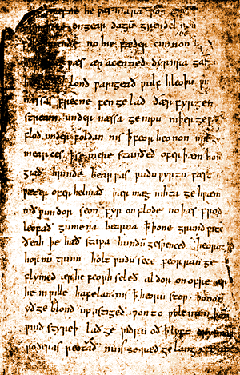
The manuscript (codex) contains five different works, and the only unifying. Fulk, based on the most recent editorial understanding, allows readers to rediscover Beowulf’s brilliant mastery along with otherworldly delights in the four companion texts in The Beowulf Manuscript. manuscript managed to survive Henry VIII’s dissolution of the monasteries, and the destruction of their great libraries since his name is written on one of the folios, Lawrence Nowell, the sixteenth-century scholar, may have been responsible for Beowulf’s preservation. It survives in only one manuscript, London British Library Cotton Vitellius A. First-time readers as well as established scholars can now gain new insights into Beowulf-and the four other texts-by approaching each in its original context.Ĭould a fascination with the monstrous have motivated the compiler of this manuscript, working over a thousand years ago, to pull together this diverse grouping into a single volume? The prose translation by R. For the first time in the history of Beowulf scholarship, the poem appears alongside the other four texts from its sole surviving manuscript: the prose Passion of Saint Christopher, The Wonders of the East, The Letter of Alexander the Great to Aristotle, and (following Beowulf) the poem Judith. It was edited in the nineteenth century and became part of the English curriculum in the twentieth century.Beowulf is one of the finest works of vernacular literature from the European Middle Ages and as such is a fitting title to head the Old English family of texts published in the Dumbarton Oaks Medieval Library.īut this volume offers something unique. There is no indication that anyone read Beowulf during the Middle Ages. The Beowulf Manuscript: The best medieval manuscripts were made of vellum (involving uteruses of unborn lambs, and so pretty exclusive).

Not implausibly (but unlikely), Kevin Kiernan of the University of Kentucky believes that Vitellius A xv is the author's autograph copy. What we have is a written document that shows signs of having been composed as a text. If the poem did exist in pieces, we can never know.

#Beowulf manuscript full#
The full film is available in streaming from our library.) More recently, this oral theory has been rejected or significantly modified. (Here is Benjamin Bagby reciting the opening lines of Beowulf and singing Grendel's attack. Oral poets sang these songs, and sometime in the later Old English period someone wrote down a scop's performance. This is called the Liedertheorie, or song-theory. One long-influential theory contends that it was combined from several shorter songs about a folkloric Bear's Son (OE beo, "bee" OE wulf "wolf/outlaw/thief" i.e., honey-thief or bear). The date of the composition of the poem is a difficult matter. Another promising argument by Michael Lapidge of Cambridge University argues on paleographical grounds that the scribes of the Cotton manuscript copied a copy the original was written down in the eighth or early ninth century. Fulk argues on linguistic grounds that the poem could not have been composed after about 725. Recent arguments fail on a number of points, although the most convincing is by Robert Fulk of Indiana University. The major arguments for the date of Beowulf are gathered in a collection of essays edited by Colin Chase. "Ībsolutely nothing is known about its author or its place of composition.

The poem is written in Old English and begins "Hwaet, we gardena in geardagum | þeodcyninga þrym gefrunon. The manuscript was burned in a fire at Robert Cotton's library in 1731. The image on the left is the first page of the poem. The poem was entitled Beowulf by modern editors. The poem was written down by two scribes around the year 1000, but was composed sometime beforehand. The manuscript is known by its library shelf mark: British Library Cotton Vitellius A. LO, praise of the prowess of people-kings. Marijane Osborn, List of translations of the poem since 1805īBC documentary on Beowulf with Michael Woodīeowulf is a character in an anonymous poem found in a single manuscript. Beowulf (modern English translation) By Anonymous Translated by Frances B.

KIERNAN Until now no one has investigated the possibility that Beowulf was composed at the time of its only. The Electronic Beowulf (2011).Ĭhambers, Beowulf: An Introduction (1921), still worthwhile! of beowulf and the beowulf manuscript KEVIN S. Beowulf and the Beowulf Manuscript (1996). Kevin Kiernans Beowulf and the Beowulf Manuscript was first published by. The Dating of Beowulf (1981).ījork, Robert. Studies in the prose texts of the Beowulf Manuscript View / Open Files Authors Date Awarding Institution Author Affiliation Qualification Type Metadata. Old English student edition, Harris (2013)Ĭhase, Colin. Crossley-Holland trans., Beowulf īenjamin Slade, trans.


 0 kommentar(er)
0 kommentar(er)
